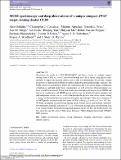Files in this item
MUSE spectroscopy and deep observations of a unique compact JWST target, lensing cluster CLIO
Item metadata
| dc.contributor.author | Griffiths, Alex | |
| dc.contributor.author | Conselice, Christopher J. | |
| dc.contributor.author | Alpaslan, Mehmet | |
| dc.contributor.author | Frye, Brenda L. | |
| dc.contributor.author | Diego, Jose M. | |
| dc.contributor.author | Zitrin, Adi | |
| dc.contributor.author | Yan, Haojing | |
| dc.contributor.author | Ma, Zhiyuan | |
| dc.contributor.author | Barone-Nugent, Robert | |
| dc.contributor.author | Bhatawdekar, Rachana | |
| dc.contributor.author | Driver, Simon P. | |
| dc.contributor.author | Robotham, Aaron S. G. | |
| dc.contributor.author | Windhorst, Rogier A. | |
| dc.contributor.author | Wyithe, J. Stuart B. | |
| dc.date.accessioned | 2018-02-27T11:30:11Z | |
| dc.date.available | 2018-02-27T11:30:11Z | |
| dc.date.issued | 2018-04-11 | |
| dc.identifier | 252405731 | |
| dc.identifier | 5e50fa57-3eaf-452f-b6f9-96b048113bad | |
| dc.identifier | 000427141900001 | |
| dc.identifier | 85094522283 | |
| dc.identifier.citation | Griffiths , A , Conselice , C J , Alpaslan , M , Frye , B L , Diego , J M , Zitrin , A , Yan , H , Ma , Z , Barone-Nugent , R , Bhatawdekar , R , Driver , S P , Robotham , A S G , Windhorst , R A & Wyithe , J S B 2018 , ' MUSE spectroscopy and deep observations of a unique compact JWST target, lensing cluster CLIO ' , Monthly Notices of the Royal Astronomical Society , vol. 475 , no. 3 , pp. 2853-2869 . https://doi.org/10.1093/mnras/stx3364 | en |
| dc.identifier.issn | 0035-8711 | |
| dc.identifier.other | ArXiv: http://arxiv.org/abs/1801.01140v1 | |
| dc.identifier.uri | https://hdl.handle.net/10023/12802 | |
| dc.description.abstract | We present the results of a VLT MUSE/FORS2 and Spitzer survey of a unique compact lensing cluster CLIO at z = 0.42, discovered through the GAMA survey using spectroscopic redshifts. Compact and massive clusters such as this are understudied, but provide a unique prospective on dark matter distributions and for finding background lensed high-z galaxies. The CLIO cluster was identified for follow-up observations due to its almost unique combination of high-mass and dark matter halo concentration, as well as having observed lensing arcs from ground-based images. Using dual band optical and infra-red imaging from FORS2 and Spitzer, in combination with MUSE optical spectroscopy we identify 89 cluster members and find background sources out to z = 6.49. We describe the physical state of this cluster, finding a strong correlation between environment and galaxy spectral type. Under the assumption of an NFW profile, we measure the total mass of CLIO to be M200 = (4.49 ± 0.25) × 1014 M⊙. We build and present an initial strong-lensing model for this cluster, and measure a relatively low intracluster light (ICL) fraction of 7.21 ± 1.53 per cent through galaxy profile fitting. Due to its strong potential for lensing background galaxies and its low ICL, the CLIO cluster will be a target for our 110 h James Webb Space Telescope ‘Webb Medium-Deep Field’ (WMDF) GTO program. | |
| dc.format.extent | 2933488 | |
| dc.language.iso | eng | |
| dc.relation.ispartof | Monthly Notices of the Royal Astronomical Society | en |
| dc.subject | Gravitational lensing: strong | en |
| dc.subject | Techniques: imaging spectroscopy | en |
| dc.subject | Galaxies: clusters: general | en |
| dc.subject | QB Astronomy | en |
| dc.subject | QC Physics | en |
| dc.subject | 3rd-NDAS | en |
| dc.subject.lcc | QB | en |
| dc.subject.lcc | QC | en |
| dc.title | MUSE spectroscopy and deep observations of a unique compact JWST target, lensing cluster CLIO | en |
| dc.type | Journal article | en |
| dc.contributor.institution | University of St Andrews. School of Physics and Astronomy | en |
| dc.identifier.doi | 10.1093/mnras/stx3364 | |
| dc.description.status | Peer reviewed | en |
This item appears in the following Collection(s)
Items in the St Andrews Research Repository are protected by copyright, with all rights reserved, unless otherwise indicated.

